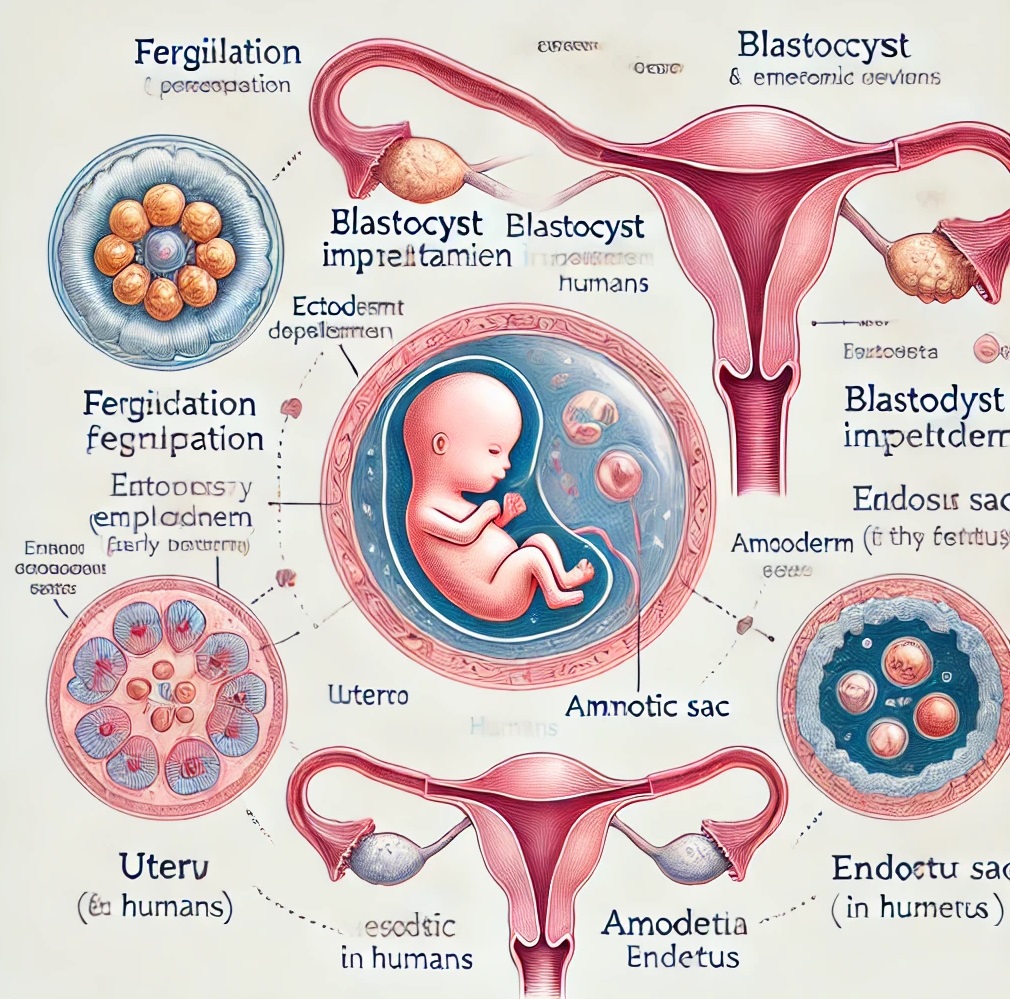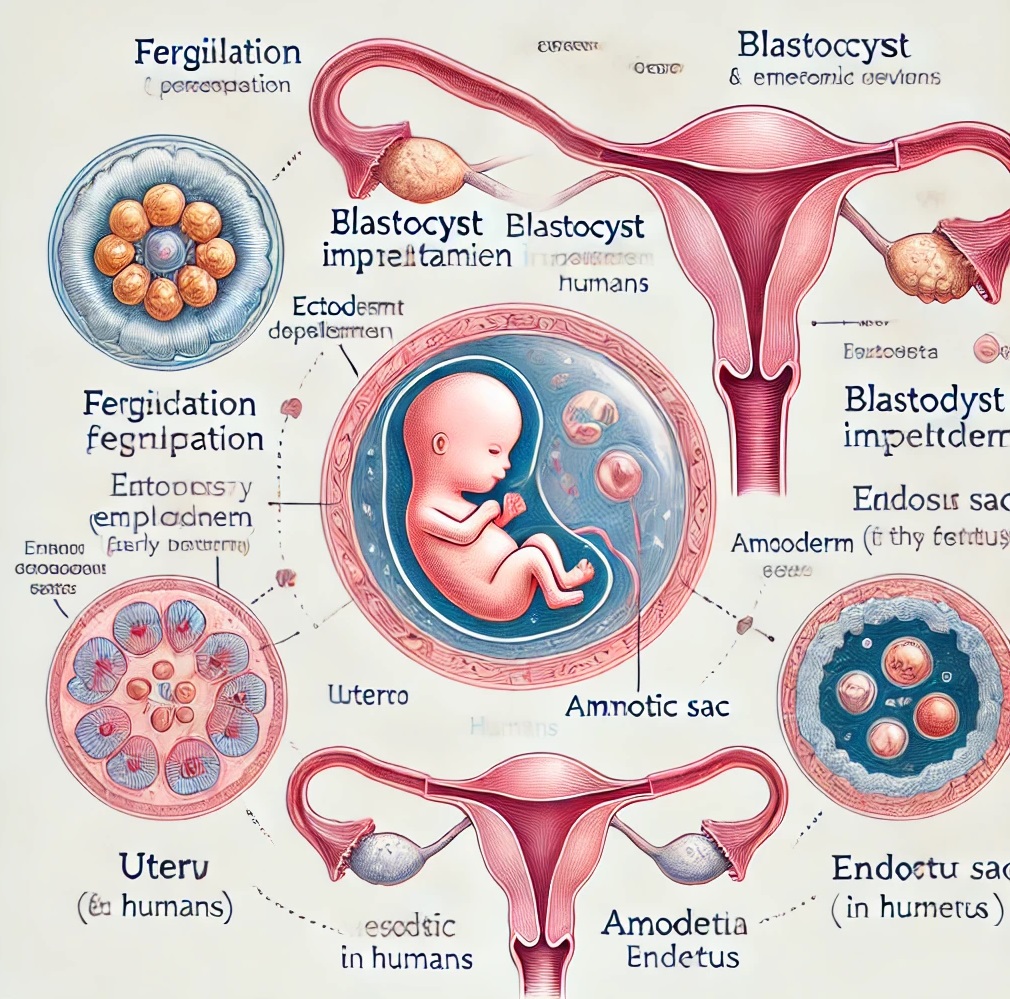
Pregnancy is a natural biological process that begins with the fertilization of an egg by a sperm and continues with the development of the embryo and fetus inside the mother’s womb. The process is intricate and involves multiple stages, each critical to ensuring the birth of a healthy baby. During pregnancy, the fertilized egg undergoes rapid cell division and gradually transforms into a fully formed baby over approximately 40 weeks.
Let’s break down the stages of pregnancy and embryonic development to understand this fascinating process step by step.
1. Fertilization and Conception
Pregnancy starts with fertilization, where a sperm fuses with an egg (ovum) in the fallopian tube. This forms a single cell known as a zygote, which contains all the genetic material (46 chromosomes) needed for the formation of a human being. Half of this genetic information comes from the mother, and the other half from the father.
Early Cell Division
After fertilization, the zygote begins to divide rapidly as it travels down the fallopian tube towards the uterus. By the time it reaches the uterus (about 3-4 days after fertilization), it has developed into a cluster of cells called a blastocyst.
2. Implantation
The blastocyst reaches the uterus and implants itself into the thickened uterine lining (endometrium) around 6-10 days after fertilization. The blastocyst consists of two main parts:
- The inner cell mass, which will develop into the embryo.
- The trophoblast, which will form the placenta.
The placenta plays a crucial role in pregnancy by providing nutrients and oxygen to the developing embryo and removing waste. It also produces hormones like human chorionic gonadotropin (hCG), which maintains the uterine lining and prevents menstruation, thus sustaining the pregnancy.
3. Stages of Embryonic Development
Embryonic development is divided into three key stages:
- Germinal Stage (Weeks 1-2)
- Embryonic Stage (Weeks 3-8)
- Fetal Stage (Week 9 onward)
3.1. Germinal Stage (Weeks 1-2)
This stage covers the period from fertilization until implantation. During this time, the fertilized egg travels to the uterus and implants itself into the uterine lining. The cells of the blastocyst begin to differentiate, forming the foundation for the embryo and the placenta.
- Key Processes:
- Rapid cell division (cleavage) of the zygote.
- Formation of the blastocyst.
- Implantation in the uterus.
3.2. Embryonic Stage (Weeks 3-8)
This is a critical phase in pregnancy, as all major organs and body systems start to develop during these weeks. The embryo undergoes a process called gastrulation, where three primary germ layers are formed:
- Ectoderm: Forms the nervous system, skin, and hair.
- Mesoderm: Develops into muscles, bones, the circulatory system, and reproductive organs.
- Endoderm: Becomes the respiratory and digestive systems.
By the end of the embryonic stage, the basic structures of the heart, brain, spinal cord, and limbs are in place. This is a highly sensitive period where the embryo is most vulnerable to harmful environmental factors like toxins and infections.
- Key Developments:
- Formation of the neural tube (which becomes the brain and spinal cord).
- Beginning of heartbeats around week 6.
- Limb buds appear and start developing into arms and legs.
- Eyes, ears, and mouth begin to form.
3.3. Fetal Stage (Week 9 Onward)
After the embryonic stage, the developing baby is called a fetus. During the fetal stage, the body systems formed during the embryonic phase grow and mature. This stage lasts from week 9 until birth (usually around 40 weeks of gestation).
- Key Developments:
- Growth of the fetus accelerates.
- The brain and nervous system continue to develop and become more complex.
- The fetus begins to make movements by week 16.
- By week 24, the lungs are developing, though they won’t be fully mature until closer to birth.
- By week 28, the fetus can open its eyes and respond to light and sound from outside the womb.
- The fetus gains more fat in the later weeks to prepare for birth.
4. Hormonal Changes During Pregnancy
During pregnancy, the body undergoes various hormonal changes to support the growing fetus. Some of the key hormones involved include:
- Human Chorionic Gonadotropin (hCG): Produced by the placenta, hCG prevents the uterus from shedding its lining and supports the early stages of pregnancy.
- Progesterone: This hormone is crucial for maintaining the uterine lining and preventing contractions in the uterus that could lead to premature labor.
- Estrogen: Increases the size of the uterus and helps develop the baby’s organs. It also promotes breast development in preparation for lactation.
- Relaxin: Relaxes the ligaments in the pelvis and softens the cervix, preparing the body for labor and delivery.
5. Maternal Changes During Pregnancy
Pregnancy affects a woman’s body in many ways. Some of the most noticeable changes include:
- Weight Gain: A healthy weight gain of about 25-35 pounds is recommended during pregnancy.
- Changes in Blood Volume: The mother’s blood volume increases by up to 50% to provide sufficient oxygen and nutrients to the developing fetus.
- Breast Changes: The breasts grow larger and may become more tender as they prepare for breastfeeding.
- Morning Sickness: Many women experience nausea and vomiting, especially in the first trimester, due to increased HCG levels.
6. Critical Milestones in Fetal Development
- Week 4: The heart begins to beat.
- Week 6: Brainwaves can be detected.
- Week 9: The embryo officially becomes a fetus, and essential body structures are formed.
- Week 12: The fetus has formed reflexes and can make movements.
- Week 16: The mother may begin to feel fetal movements, often called “quickening.”
- Week 24: The fetus reaches viability, meaning that with medical support, it could potentially survive outside the womb.
- Week 37: The fetus is considered full-term, and all organs are fully developed.
7. The Third Trimester and Preparation for Birth
The third trimester lasts from week 28 until birth. During this period, the fetus gains significant weight, and its organs mature further. The mother may experience back pain, swelling, and increased fatigue as the baby grows larger.
- Preparing for Birth: As the due date approaches, the fetus will shift into a head-down position in preparation for delivery. Hormones like oxytocin will help trigger labor when the time comes.
See in Fig:

The Fig. depicts key phases, including fertilization, blastocyst implantation, the formation of the germ layers, and the growth of the fetus within the uterus.
Important Questions and Answers related to Pregnancy and Embryonic Development
1. What is the duration of a typical human pregnancy?
- Answer: A typical human pregnancy lasts around 40 weeks or 9 months, divided into three trimesters.
2. What is the first stage of development after fertilization?
- Answer: The first stage after fertilization is the zygote stage. The zygote undergoes rapid cell division (cleavage) to form a blastocyst.
3. What is the blastocyst, and what is its role in pregnancy?
- Answer: A blastocyst is a structure formed in early development, about 5 days after fertilization. It contains an inner cell mass that will develop into the embryo and an outer layer (trophoblast) that will form the placenta. The blastocyst implants in the uterus to initiate pregnancy.
4. What is implantation and when does it occur?
- Answer: Implantation is the process where the blastocyst attaches itself to the lining of the uterus (endometrium). It typically occurs 6-10 days after fertilization.
5. What are the three primary germ layers formed during the embryonic stage?
- Answer: The three germ layers formed during the embryonic stage are:
- Ectoderm: Forms the nervous system, skin, and hair.
- Mesoderm: Develops into muscles, bones, and the circulatory system.
- Endoderm: Forms the digestive and respiratory systems.
6. At what stage does the embryo become a fetus?
- Answer: The embryo becomes a fetus at the beginning of the 9th week of pregnancy, marking the start of the fetal stage.
7. What is the role of the placenta during pregnancy?
- Answer: The placenta provides nutrients and oxygen to the developing fetus, removes waste products, and produces hormones like hCG (human chorionic gonadotropin) that help maintain pregnancy.
8. When can the mother typically feel the baby’s movements?
- Answer: The mother usually begins to feel fetal movements, known as quickening, between weeks 16-20 of pregnancy.
9. What is the purpose of amniotic fluid?
- Answer: Amniotic fluid surrounds the fetus, providing protection and cushioning, maintaining a stable temperature, and allowing the fetus to move and develop properly.
10. Which hormone is primarily responsible for maintaining the uterine lining during pregnancy?
- Answer: Progesterone is the hormone that maintains the uterine lining (endometrium) during pregnancy, preventing contractions that could lead to miscarriage.
11. What happens during the third trimester of pregnancy?
- Answer: During the third trimester, the fetus undergoes rapid growth, its organs mature, and it gains weight in preparation for birth. By week 37, the fetus is considered full-term.
12. What is the critical period for organ development in the embryo?
- Answer: The critical period for organ development is during the embryonic stage, specifically from weeks 3 to 8 of pregnancy. During this time, the brain, heart, limbs, and other essential structures begin to form.






